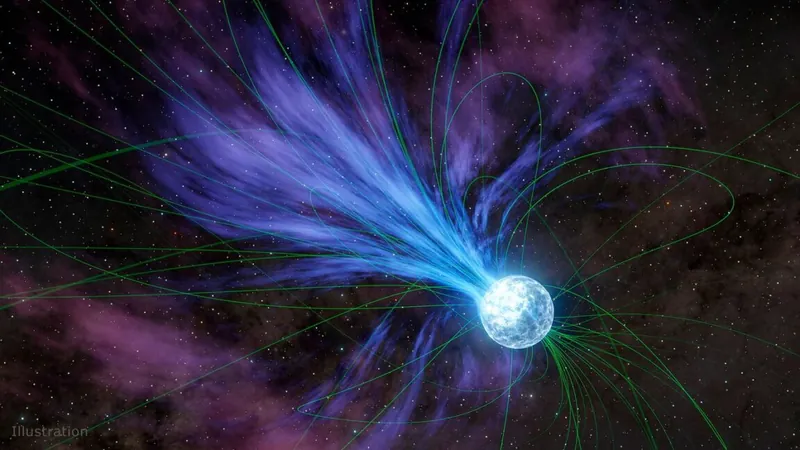
Shocking Discovery: Fast Radio Bursts Likely Emanate from Star Surfaces!
2025-01-03
Author: Wei
Groundbreaking Revelation in Astrophysics
In a groundbreaking revelation for astrophysics, scientists are uncovering secrets about the enigmatic phenomenon of fast radio bursts (FRBs), first detected in 2007. These mysterious radio emissions, characterized by their brief yet intense bursts followed by silence, have puzzled researchers for over a decade. Although some FRBs are known to occur repeatedly, many remain single events—leaving scientists scrambling for answers.
The Role of Magnetars
Recent research has shifted the focus towards magnetars, which are highly magnetic neutron stars, as potential sources of these bursts. However, the jury is still out on whether magnetars are the sole producers of FRBs or if less magnetized neutron stars might also play a role. Adding to the intrigue, scientists are still working to understand the precise mechanisms behind FRBs. Could it be linked to intense magnetic activities within the star, or is it the result of material ejected from the star that creates an FRB as it travels through space?
The Importance of FRB 20221022A
A significant breakthrough has emerged following the observation of a rare FRB designated FRB 20221022A, detected in October 2022 by the Canadian Hydrogen Intensity Mapping Experiment (CHIME). This observatory, designed for analyzing radio emissions across the sky, provided the perfect setup for capturing this critical event.
Nearby Galaxy Insights
What's truly stunning is the discovery that this FRB was linked to a relatively nearby galaxy, situated about 200 million light-years away. The proximity of this galactic neighbor was crucial, as it allowed scientists to conduct in-depth analyses of the burst's properties. More importantly, it meant that the light and radio waves emitted had traveled less distance through intergalactic space, enabling clearer study of interactions with materials within the galaxy itself—both in the source galaxy and our Milky Way.
Fascinating Polarization Changes
Astrophysicists were particularly fascinated by the polarization changes observed in the photons from FRB 20221022A. The rapid transformation of polarization angle, documented over the brief duration of just 2.5 milliseconds, suggests profound implications. This 130-degree shift mirrors a behavior noted in numerous pulsars—another type of rapidly rotating neutron star that emits beams of radiation. This correlation strongly indicates that the FRB likely originates from a compact, rapidly spinning object, closely resembling pulsar activity.
Interstellar Medium Interactions
The complexity of FRBs deepens with the second analysis that focused on the FRB's interactions with the interstellar medium. Scientists discovered that the burst underwent multiple encounters with matter, affecting its signal and leading to scintillation—a phenomenon akin to stars twinkling in our atmosphere. With the near proximity of the source galaxy, researchers discovered a two-source scintillation pattern, which leads to the conclusion that the FRB was likely launched from close to the source, negating theories involving material colliding at great distances.
Implications for Future Research
This research not only rules out less relevant models but aligns with the behavior of pulsars and hints strongly at the magnetar's pivotal role in generating these bursts. But the quest for knowledge doesn’t stop here. A pressing question lingers: Do these findings pertain to all FRBs, including those that display repetitive behavior? It's highly possible that diverse mechanisms could be at play, making some FRBs distinct and perhaps part of an intricate cosmic tapestry. Nevertheless, with each observation, we inch closer to unraveling the complex nature of these cosmic events, paving the way for future discoveries.
Conclusion and Future Discoveries
Stay tuned—our understanding of the universe is changing, and who knows what else is waiting to be discovered in the cosmic radio waves!

 Brasil (PT)
Brasil (PT)
 Canada (EN)
Canada (EN)
 Chile (ES)
Chile (ES)
 Česko (CS)
Česko (CS)
 대한민국 (KO)
대한민국 (KO)
 España (ES)
España (ES)
 France (FR)
France (FR)
 Hong Kong (EN)
Hong Kong (EN)
 Italia (IT)
Italia (IT)
 日本 (JA)
日本 (JA)
 Magyarország (HU)
Magyarország (HU)
 Norge (NO)
Norge (NO)
 Polska (PL)
Polska (PL)
 Schweiz (DE)
Schweiz (DE)
 Singapore (EN)
Singapore (EN)
 Sverige (SV)
Sverige (SV)
 Suomi (FI)
Suomi (FI)
 Türkiye (TR)
Türkiye (TR)
 الإمارات العربية المتحدة (AR)
الإمارات العربية المتحدة (AR)